For today’s post, I am at the highest point in the metropolitan London area, standing opposite Jack Straw’s Castle.
Jack Straw’s Castle was one of the most well known pubs around Hampstead Heath. A coaching inn as well as a place for those walking across the heath to visit, along with weekend and Bank Holiday crowds.
My father photographed the building just after the last war and the photo below is his view of Jack Straw’s Castle in 1949.
This was my view in March 2019:
You may well be wondering how I know that my father’s photo is of Jack Straw’s Castle, given the changes between 1949 and 2019, however if you look at the very top of the tallest building, the faded words Jack Straw’s Castle can just be seen. Also, the building on the far left of both photos, along with the brick wall with two pillars, are the same in both photos.
My father’s photo shows the pub as it was following bomb damage in 1941 and subsequent demolition of some of the walls to make the building safe. The Daily Herald on the 29th March 1941 carried a report titled “Jack Straw’s Castle Bombed – the old Hampstead hostelry, was among places recently damaged during air-raids. Its neighbour, Heath House, the home of Lord Moyne, leader of the House of Lords, was also damaged.”
The building was demolished and rebuilt in 1964 to a rather striking design by Raymond Erith, however it is no longer a pub, having been converted into apartments and a gym. The building is Grade II listed which has helped to preserve key features of Erith’s design, despite developers trying to push the boundaries of how much they could change.
Jack Straw, after who the pub was named, is a rather enigmatic figure. General consensus appears to be that he was one of the leaders of the Peasants Revolt in 1381, however dependent on which book or Internet source is used, he could either have led the rebels from Essex, or been part of the Kent rebellion. Jack Straw may have been another name for Wat Tyler and some sources even question his existence. Any connection with Hampstead Heath and the site of Jack Straw’s Castle seem equally tenuous – he may have assembled his rebels here, made a speech to the rebels before they marched on London, or escaped here afterwards.
Jack Straw is mentioned by Geoffrey Chaucer in the The Nun’s Priest’s Tale of The Canterbury Tales:
Out of the hyve cam the swarm of bees.
So hydous was the noyse — a, benedicitee!
Certes, he Jakke Straw and his meynee
Ne made nevere shoutes half so shrille
Whan that they wolden any Flemyng kille
Given The Canterbury Tales were written not long after the Peasants Revolt, this reference by Geoffrey Chaucer does probably confirm his existence. The reference to “Flemyng kille” is to the targeting of the houses of Flemish immigrants in London by the rebels.
I cannot though find any firm evidence of Jack Straw’s association with Hampstead or the site of the pub.
My father’s photo was of a rather sad looking building, however before the bombing of 1941, Jack Straw;s Castle was a rather lovely coaching inn. The following photo is from a postcard from around or just before the First World War showing Jack Straw’s Castle, and demonstrating that part of the series of buildings was the Castle Hotel.
It all looks rather idyllic. A cart is parked outside, a well dressed couple are entering the Castle Hotel, and there are small trees and plants growing in frount of the buildings. The road to Golders Green disappears off past the buildings.
The rear of the postcard reveals that London was not so idyllic when it was posted. The card is dated 10th September 1915 and the author has written “The Zeppo did a lot of damage here”, probably referring to the raid on the 8th September 1915 when a Zeppelin attacked London, dropping the largest bomb to land on the city during the first war, with the raid killing 22 people in total.
A later photo than the above postcard as the pub has now lost the bay windows on the ground floor and has the windows that would remain in my father’s photo.
The two carts in the above photo possibly delivering Nevill’s Bread to Jack Straw’s Castle and Hotel, along with a delivery from the Civil Service Cooperative Society.
In the following photo, the cart is delivering High Class Table Waters.
The above photo shows how there are frequently traces of previous buildings in the buildings we see today. Jack Straw’s Castle was a Coaching Inn, and the large doors on the left have “Livery & Bait Stables”, but compare the position of these large doors with my 2019 photo above and you will also see a large set of doors in roughly the same position, although the 1964 version of Jack Straw’s Castle had no need to provide a stables.
A view of Jack Straw’s Castle, the origin of the name and some of the visitors to the inn is provided by Edward Walford in Old and New London (published in 1878);
“To Hampstead Heath, as every reader of his ‘Life’ is aware, Charles Dickens was extremely partial, and he constantly turned his suburban walks in this direction. He writes to Mr. John Forster: ‘You don’t feel disposed, do you, to muffle yourself up and start off with me for a good brisk walk over Hampstead Heath? I know of a good house where we can have a red-hot chop for dinner and a glass of good wine.’ ‘This note’ adds Forster, ‘led to our first experience of Jack Straw’s Castle, memorable for many happy meetings in coming years.’
Passing into Jack Straw’s Castle, we find the usual number of visitors who have come up in Hansoms to enjoy the view, to dine off its modern fare, and to lounge about its gardens. The inn, or hotel, is not by any means an ancient one, and it would be difficult to find out any connection between the present hostelry and the rebellion which may, or may not, have given it a name. The following is all that we could glean from an old magazine which lay upon the table at which we sat and dined when we last visited it, and it is to be feared that the statement is not to be taken wholly ‘ for gospel’ – Jack Straw, who was second in command to Wat Tyler was probably entrusted with the insurgent division which immortalised itself by burning the Priory of St. John of Jerusalem, thence striking off to Highbury, where they destroyed the house of Sir Robert Hales, and afterwards encamping on Hampstead heights. Jack Straw, whose castle consisted of a mere hovel, or a hole in the hill-side, was to have been king of one of the English counties – probably of Middlesex; and his name alone of all the rioters associated itself with a local habitation, as his celebrated confession showed the rude but still not unorganised intentions of the insurgents to seize the king, and, having him amongst them, to raise the entire country.
This noted hostelry has long been a famous place for public and private dinner-parties and suppers, and its gardens and grounds for alfresco entertainments.”
Gardens at the back of pubs and inns have probably been a popular attraction for as long as these establishments have existed, and today a pub with a garden is a perfect place to spend a summer’s evening or weekend afternoon. The garden at the back of Jack Straw’s Castle looks perfect in this drawing from 1830 by George Scharf (©Trustees of the British Museum).
The drawing is interesting as it appears to contain notes for a later coloured version. Scribbled text alongside the building record that the chimney is light yellow, the boards are stone colour and the brick wall is yellow.
Jack Straw’s Castle was obviously a local landmark in what was a very rural area. The following print from 1797 showing an old cottage surrounded by trees and bracken and is labelled “Near Jack Straw’s Castle, Hampstead Heath” as the inn was probably the only local reference point (©Trustees of the British Museum).
My father’s photo was of the building just after the war showing a shadow of the former inn. The following photo from 1941 shows Jack Straw’s Castle in 1941 in the days following the bombing.
The windows have been blown out, but difficult to see what other damage has been caused to the structure of the building. From this photo I would have expected that Jack Straw’s Castle could have been repaired, however shortage of materials and people during the war probably prevented any repair work, and over the years any structural damage and the building being left in this state resulted in the building being unsafe, and walls demolished to result in the building that my father photographed.
Although Jack Straw’s Castle is very different, the buildings to the left look as if they are much the same as their original construction.
There appear to be four individual houses in the above photo. The name adjacent to the entrance is “Old Court House”. The Victoria County History volume for Hampstead refers to these buildings as having been built by Thomas Pool who purchased Jack Straw’s Castle in 1744 and built two houses in 1788. The Victoria County History states that in 1820 they were converted into a single house, with name changes over the years of Heath View, Earlsmead, and finally Old Court House.
Underneath the name plate is an intercom system with four buttons so I assume they are four individual homes, but how and when they converted from the original two houses to the current buildings, I am unsure.
Jack Straw’s Castle sits on a very busy road junction, where roads from Hampstead, Highgate and Golders Green converge. Whilst I was trying to take photos there was a continuous stream of traffic.
In the following photo, the road on the left leads to Golders Green, the road on the right leads to Highgate (passing a building which is still a pub – the Spaniards), and I am standing by the road that leads up from Hampstead.
After visiting Jack Straw’s Castle, I walked down into Hampstead. This took me alongside Whitestone Pond.
The pond was originally named Horse Pond as it was a drinking point for horses on the passing road, I will find the origin of the new name in a moment.
This area is the highest point in London, with according to the Ordnance Survey map, the pond being at 133m above sea level and Jack Straw’s Castle being at 135m.
It was originally fed by rain water and dew, however I believe it now also has an artificial supply as the height of the pond means there was no natural underground or stream sources of water.
This view dates from 1936 and shows Whitestone Pond, with the side of the Old Court House and Jack Straw’s Castle in the distance.
I took the following photo of the same view, but I have no idea why I stupidly did not move to get the tree in a different position as it is obscuring the war memorial which can be seen in the distance in the 1936 view.
Just to the left of where I was standing for the above photo, is the source of the name Whitestone Pond. 
This is a milestone and states “IV miles from St Giles, 4 1/2 miles 29 yards from Holborn Bars”. There is a similar milestone near the Flask pub in Highgate (see my post here) which gives a distance of 5 miles from St Giles Pound. These two milestones show that there were two main routes, either side of Hampstead Heath, leading down to St. Giles and then via Holborn, into the City.
There is one final unexpected find before heading off down into the centre of Hampstead, close to the milestone is a covered reservoir with an unusual looking dome on top.
This is the astronomical observatory of the Hampstead Scientific Society – a rather unique place to observe the night sky, high above the rest of London. One of the very few locations across London that provides public viewing. Unfortunately, the observatory is currently closed whilst restoration work is carried out.
It is a shame that Jack Straw’s Castle is no long a pub. It is an impressive building in an equally impressive location – although I must admit that i prefer the pre-war building. I have read so many different interpretations of the origin of the name Jack Straw and possible associations with Hampstead so i suspect we will never know the truth behind Jack Straw, but it is good that there is still a very visible reminder of the Peasants Revolt at the highest spot in Hampstead, 638 years after the event.

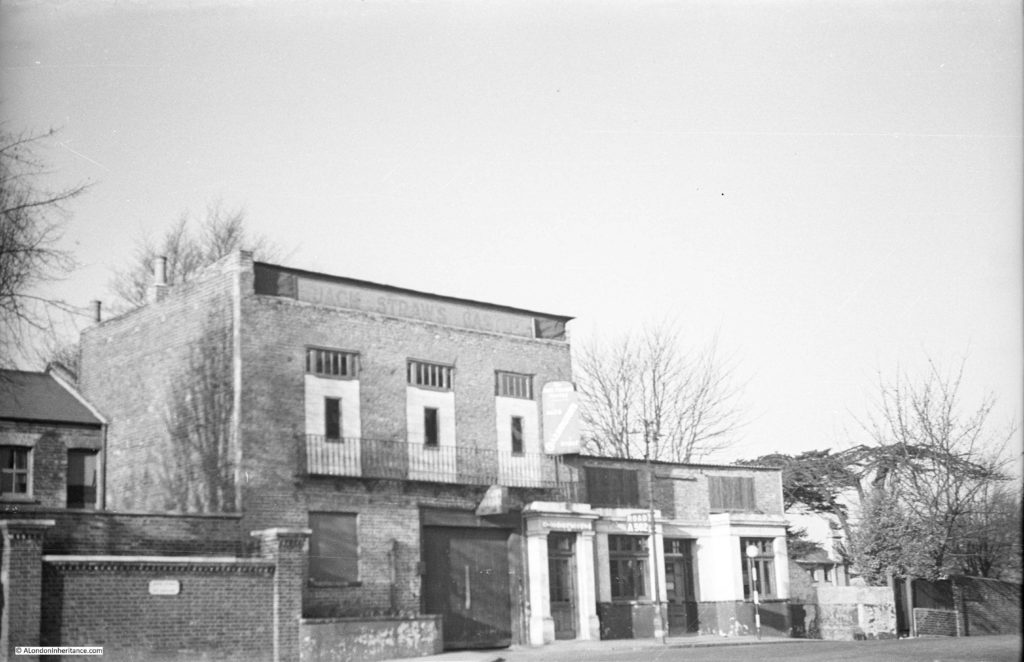
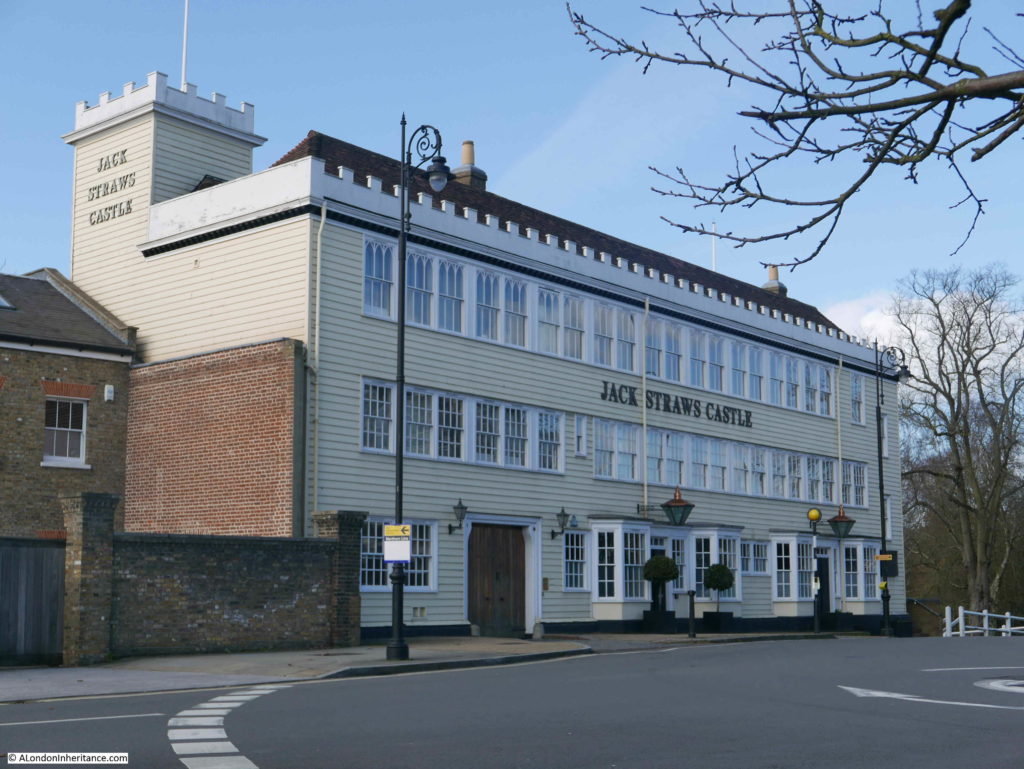
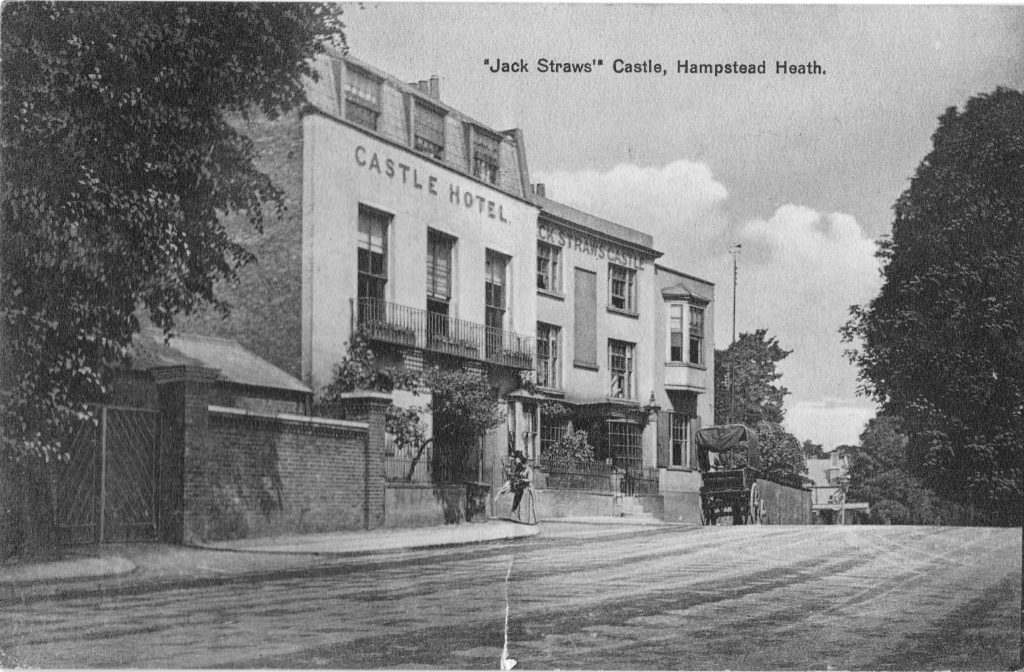

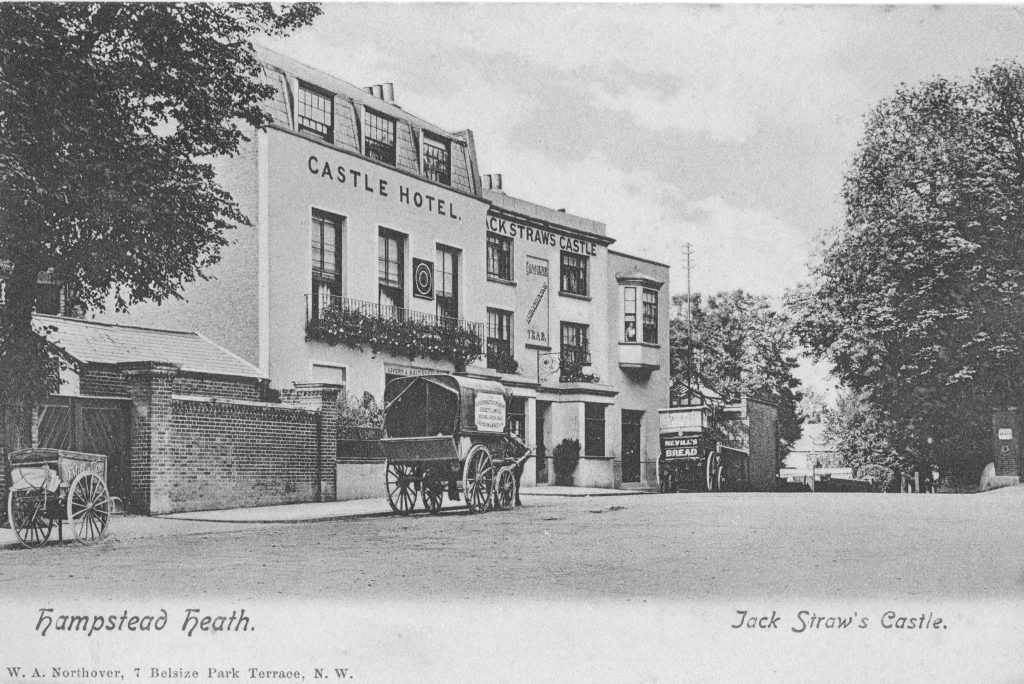


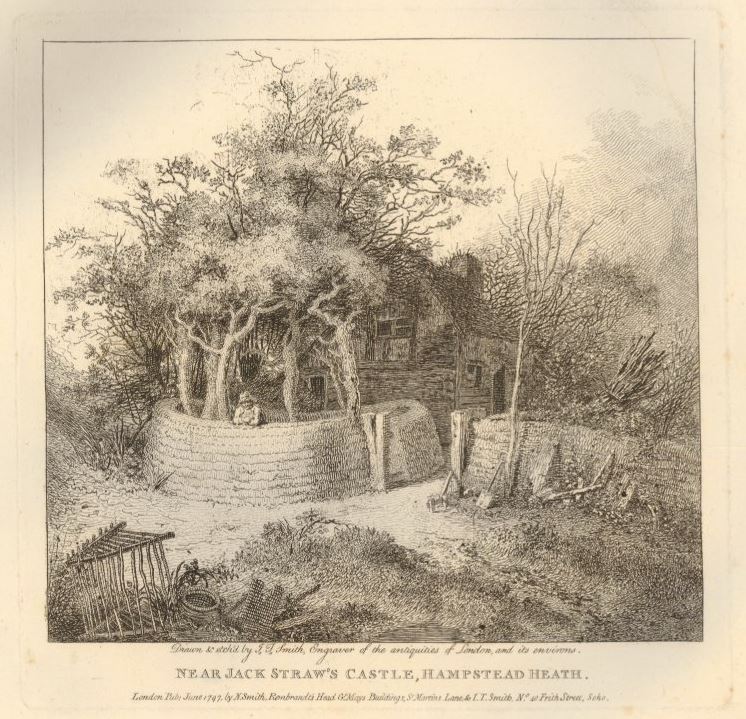
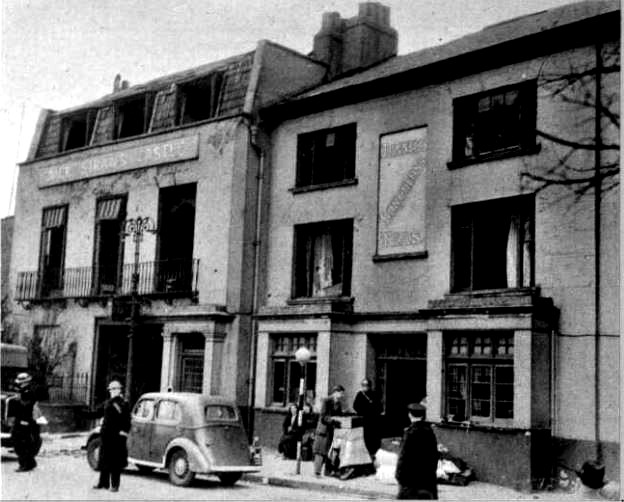

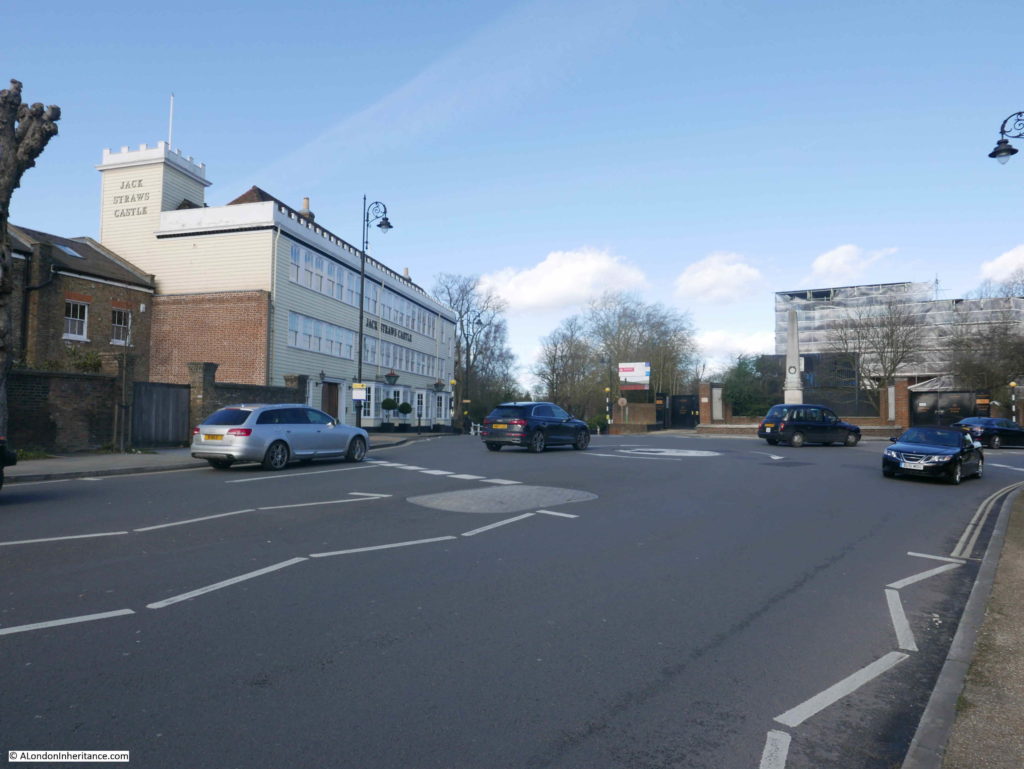
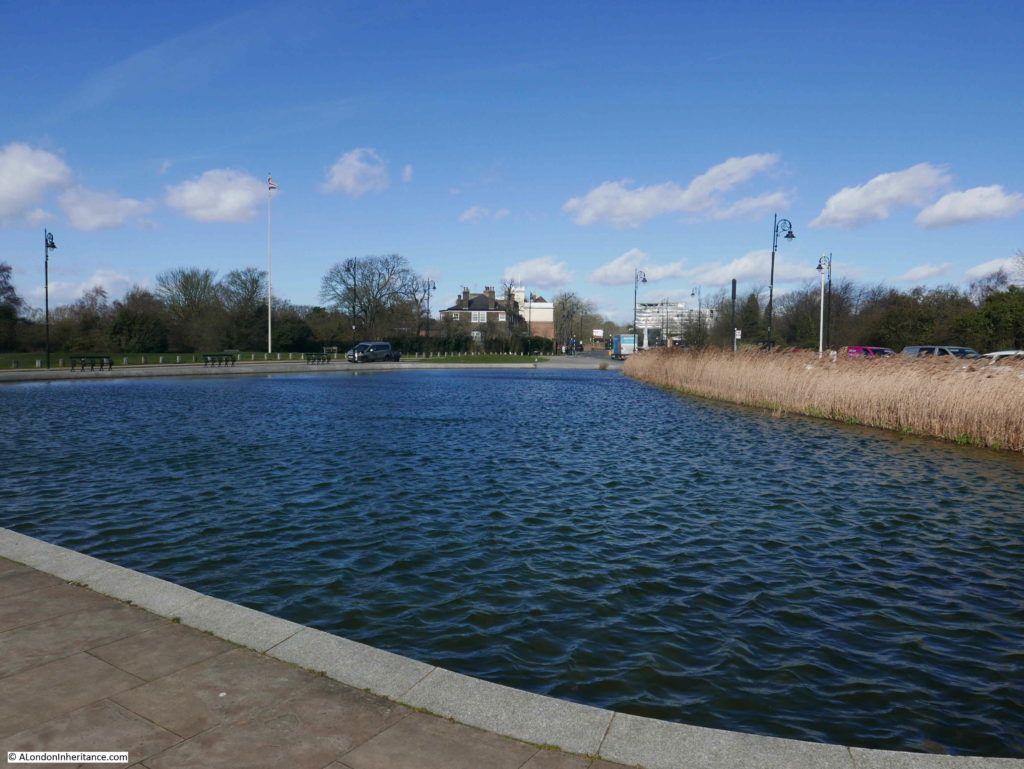
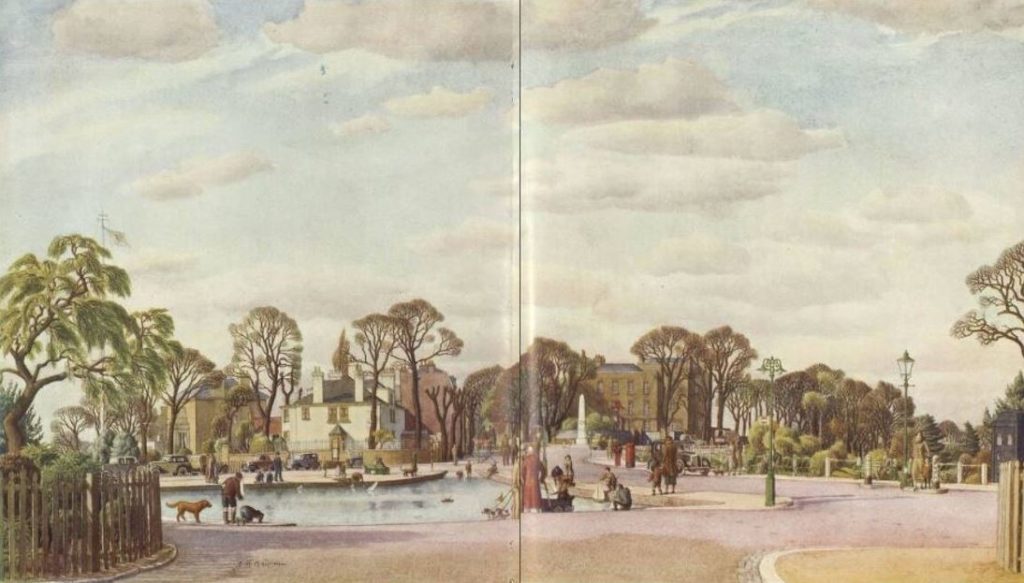

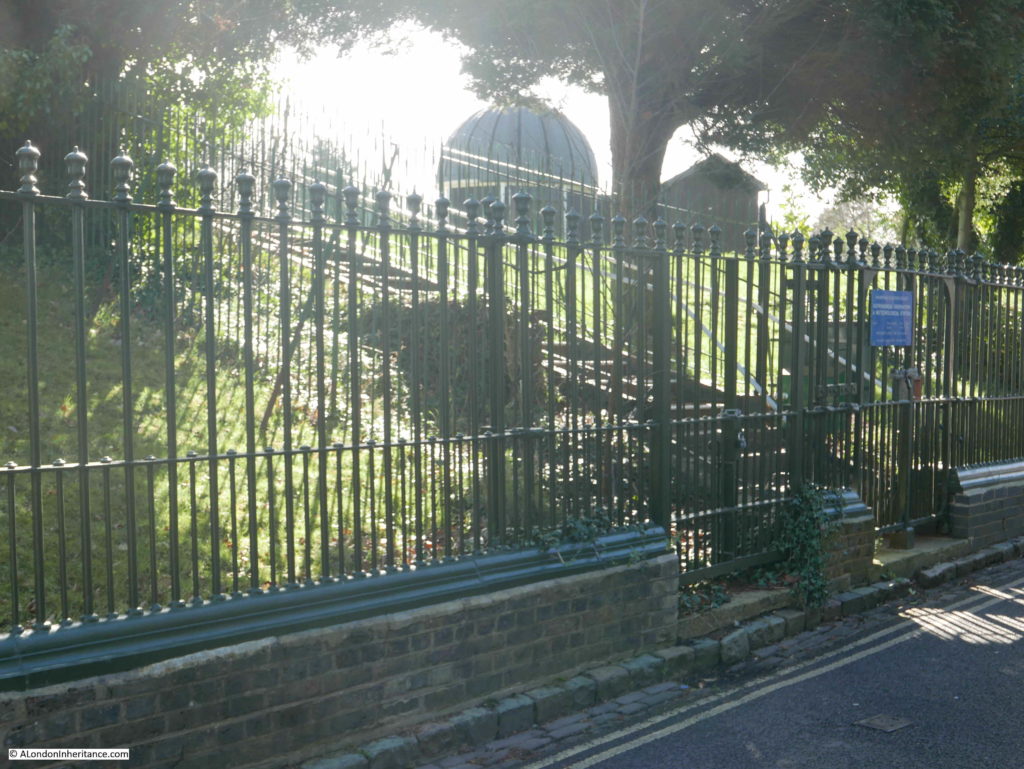
My dad, (born in 1901 in the area) took me many times to this part of Hampstead. We’d go mainly to sail my pond yacht, the pond being a favourite sailing pond for enthusiast as it was not deep and had a concrete bottom so was safe for me to wade out to retrieve a stranded model.
Always known as the Leg of Mutton pond, the name Whitestone Pond being new to me.
Dad told me that it’s original purpose was allow wagons and carts to drive in and soak the wooden wheels – which if dried out in hot weather the spokes would become loose. This accounts for the two in and out ramps.
Thank you. I have wondered about those ramps on occasion when I’ve walked past the pond. Fascinating.
I too visited Whitestone pond in the 50’s, watching men and lads sailing their model boats. I progressed, in the 60’s, to enjoying a tipple in Jack Straw’s Castle before returning across the heath to Parliament Hill Fields, Swains Lane, and home to Chester Road. Always was a wonderful walk and still is. 60 years later. My father, Eric Clarke, as a greengrocer of Dartmouth Park Hill, had horses and carts to collect goods from Covent Garden market and then distribute them to his customers; he said that the pond was not only a watering hole, but also served to rehydrate the cart’s wheels, and cool the horses down in warm weather.
I have fond memories of walking over the Heath extension or up through the Heath itself from Goders Grenn to Whitestone Pond .with my father on Sunday mornings in the 1950’s and early 60’sI’m my memories I think of Jack Straws Castle as a functioning pub and don’t remember the bomb damage. Did the pub reopen for a while before being redeveloped or do I merely have a sentimental reconstruction. Of the past.. I remember too children sailing boats and paddling in the pond.
Great post. Many thanks.
I was told the pond was so farmers carts could have the country mud washed off their wheels before proceeding down the gentrified streets of London.
One day,I really will go to Hampstead and the heath. Never been there, but there’s still time. Of course, Admin, if you keep coming up with such excellent posts, I feel as though I know it already.
I do as well! and I live in New Zealand!! 🙂
Another interesting post, thank you
After writing my 40/50’s memories of Whitestone Pond (aka ‘the Leg of Mutton pond’) I remembered that somewhere I have a beer mat, picked up when visiting Jack Straw’s Castle in the 70’s. Would you believe it, there it was, next to my favourite chair. I’ve scanned it and now have placed it in a safe place.
Thank you for this memory jogging post.
I think you will find that the current incarnation of Jack Straw’s Castle is much later than 1964. The old buildings were a functioning pub (from vague recollection probably up to the late 1990s) and were then redeveloped as residential/office/gym. The current building is much bulkier than the original (or the later) pub.
I also thought that. Knowing that area really well, over a long period of time, I thought it was a pub until much later. And, I am there all the time and that building is way later than 1964, and also its kind of use.
Too bad.
You are right. I had a drink there in 1979, so it still was a pub then. There’s a line in Pinter’s play “No Man’s Land” which was written and set in the 1970s, where one character asks another if he hangs out at Jack Straw’s Castle.
Yes. I remember drinking there in about 1997/8. It was rather tired and run down then though.
Thanks for a marvelous post concerning a place I visit often when in town. I never took the time to look up the history or current use of Jack Straw’s Castle or Whitestone Pond. I’ve walked past this spot many times on jaunts around the area, particularly on the way to or from the upper Heath and one of my favorite spots in London: the Hill Garden & Pergola just up North End Way a hundred yards or so. I’ve also walked past the White Stone marker many times heading up Hampstead Grove past Fenton House to the Hill Garden and never noticed it there, tucked away to the left.
The Vale of Health, just east of Jack Straw’s Castle, down in a secluded dell at the edge of the Heath, is also a splendid little residential nook through which to walk.
Here’s a photo of Jack Straw’s Castle in 1962, shortly before it was rebuilt: https://www.gettyimages.co.uk/detail/464416971.
Looking at the old pictures noticed the absence of street furniture and clutter not like now ,lovely part of London still -great article as usual.
Thanks for these great photos of Jack Straw’s Castle and also to Malcolm, for the link to it as I remember it in the 1950’s and 60’s…my mother was appalled when it was changed into a mock-castle and never got used to it. It still gives me a shock! However the history of Jack Straw’s connection to it is very interesting.
The Whitestone Pond was renovated (late 1950’s?) and ended up with a lot more concrete round it…I seem to remember the south side being open to wade into. I remember it had a Punch and Judy show there several times a year.
And incidentally, Leg of Mutton Pond is right down past the Vale of Health, and is much bigger than the Whitestone Pond…that’s the pond where children went fishing, and probably still do…
Whitestone pond was renovated much more recently (last 10/15 years) with tall grass around the edges. I live a mile or two away and my daughter was born in the maternity hospital (since demolished) on the corner of East Heath Rd.
Often visited Jack Straws back in sixties. One of a few pubs in North London where one could take a lady to impress!
My friend’s brother was the last licensee of Jack Straw’s Castle. Late 1990’s. so we had the privilege of being able to roam all over the building. I remember one rather drunken evening, when the pub has closed for the night, exploring all the floors and rooms. We sat for some time in a square room at the rear of the building on the top floor (not shown in any photographs). Fabulous views of the lights across north London. I never visited again and it closed soon afterwards.
Stumbled across your website while researching a will of 1825. This will states – ‘Have two copyhold tenements lately converted into one on Hampstead Heath standing on the west side of the road leading to Highgate and London and on the southwest side of a messuage or tenement here called Jack Straw’s Castle, in the occupation of Anthony Spedding, Esq.
My question to you is: Is your picture of the 4 houses identified in County History as built in 1700’s on the southwest side of Jack Straw’s Castle??? If so, then the property was owned by John Stride, Esq. Attorney of 24 Carey Street, Lincoln’s Inn Fields who passed away in 1825.
Thanks for a really wonderful blog, though time does disappear quickly when I start reading here.
I can remember driving past Jack Straw’s Castle, it must have been in the late 1990s, and seeing a chalk board on the pavement outside advertising that they had “Mrs O’Keefe’s Famous Sausages” on the menu. However some wag had rubbed out the final letters of the first and last words. The simplicity of the change lends it a certain memorable elegance.
Many memories of Jack Straw’s Castle – worked (and lived) there in approx 1980 (give or take a few years) – Cannot remember the landlord’s name at the time, but remember the manager Ronnie Webb who was a lovely, funny man and a pleasure to work for. He later went on to run a pub in East Smithfield called The Moorings. Would love to know where he is and what he is up to now.
I too worked there from 1975 to 1981. I knew Ronnie well, along with his lovely girlfriend Lesley. Roy Black was the landlord until about 1979 when Ted and Cath Haldane took over. Ted sadly passed away in the early ’80s.
I stayed in touch with Ron for a while. After The Moorings he worked in a number of other pubs but we sadly lost touch.
I have very fond memories of the pub, its customers and all the other barstaff I worked with over the years.
Fun times.
Murray… I’m sure I worked with you at Jack Straws!! Were you tall and I hate to say it….did you have a curly perm. We used to go to a Greek restaurant in Camden Town…also working there at the time were Chris (aka Animal) and his lovely wife Muriel. I remember Lesley as well….hopefully her and ronnie stayed together. Roy Black had a son called Ian
Hi Annette, that sounds like a fair description. I have been trying to forget the perm for the last 40 years! Not my best decision. But unless I’m mistaken, you also had curly hair.
Yes, we definitely worked together. Chris and Mu were there, they got married but I don’t think it lasted. I also believe that Ron and Lesley went their separate ways. Shame. I carried on working there after Roy (and Norma?} retired. Not sure what became of Ian.
Many a fun evening was spent in The Byron restaurant in Camden. I still have some photos somewhere.
I live in Maida Vale these days but often go up to Hampstead. Much of it has changed but a lot is still the same and I have so many good memories. The Spaniards is my favourite pub nowadays. As I’m sure you know, Jack Straws is now flats and a Gym but looks the same from the outside.
Are you still in London?
I’ve just found you in my “Junk” mail!!!!!!!!! So sad that Ron and Lesley parted company . I did work for Ron for a short while at The Moorings in East Smithfield but then decided to go to Gibraltar to work for the summer – which lasted almost ten years – so lost touch with everyone in London (although keeping in touch has never been my strong point anyway). I have finally settled (hate that word!) back in Southampton. My partner and I (partner is a man – I’m not gay!!!!) went to London a few years ago as I wanted a little trip down memory lane. Went to the Old Bull & Bush where I also used to work and was shocked to see Jack Straws Castle had now been converted into apartments, as I was hoping to pay a visit there as well. I remember two things distinctly about you – you went to Russia or somewhere as cold to visit your father I think – and stepped out with wet hair (that curly perm again ha ha) and you’re hair froze and the other time was you had left JS one night after work and bumped into some rival Scottish football fans by the pond and to save them pushing you in you promptly got in and sat down!!!!!! I also vaguely remember something to do with you falling asleep on a bench – but can’t remember the whole story. Are you married, do you have children – in fact I think we’re of a similar age – so I suppose I should ask if you have grandchildren. I cannot imagine living in London now but I suppose if you have always stayed there the changes aren’t noticeable – I think I’d find it all a bit too fast and overwhelming now.
Hi Murray,
Just wondering if you remember an Irish woman called Anne. She worked there from 1977 for a couple of years. Her married name was Murray…she was widowed shortly before she went to London. I think she worked in the bar for a while then went into the kitchen , she was an incredible cook! She met my stepfather there his name was Michael Wylie. It would be lovely to know if you met them. They have both passed away now.
That is a very good and interesting, thorough write up. Cheers from New Zealand
Great post and comments from everyone. I remember Jack Straw’s before it was rebuilt by Erith in 1964. My question is why is it a listed building? It would not seem that there significant national historical heritage which makes the building listed other than to keep the mandarins at Camden council in employment. I would suggest that future purchasers and tenants will be very wary of acquiring this lame duck of unsightly shiplap frontage which requires costly and frequent maintenance. I would suggest that it is put out to tender to interested architects to redesign it and turn it into something useful for the community.
My brother was a chef there in the 80s .my sister also worked there had great memories staying there at weekends .
Jack Straws Castle
A very sad end to one of London’s most famous pubs. Why would anyone believe that conversion to luxury accommodation was the right thing to do? and who agreed to it???
I became the landlord from 1983-1987. It was an amazing period, so, so busy. We had around 40 or so staff both full and part-time with 10 living on the premises. It is the highest point in London,
For anyone who doubts it….
The buildings exterior has not changed at all as far as I can tell from the original design ( built by Erith in 1964 ). It was built completely of Douglas Fir timber, of box frame structure, clad in shiplap and all interior public spaces where finished in wood panelling. It was the last all-commercial timber building to be built in London due to new fire reg’s, which are probably some of the reasons why it became listed!
As it cooled down at night it began to contract and creek. But no ghosts ever appeared!
Only the cellar was made from concrete with steel doors. Interestingly, this cellar was also designated as a nuclear fall out shelter, but for whom was not clear to me at the time!
I have the original architects concept plan and several interior photos taken of the interior during my time there.
Top (3rd floor) Consisted of the main kitchens, a 78 cover carvery restaurant and cocktail bar, previously, it was an a la Carte restaurant. This floor had 360 degree views over London
The 2nd (middle floor) was a function room and landlords accommodation of 2 bedroom apartment.
Ground floor was on huge L shaped bar and snack bar with a rear garden which could seat around 150 people. with 3 cottages which originally where little shops but during my time became staff cottages.
The cellars where massive and due to such high volume of beer sales, Charringtons the brewers who owned this building, installed huge stainless steel tanks which replaced having to roll so many 52 gallon barrels in each week. Beer would be pumped in weekly via a tanker!
I left in 1987 and moved to Jersey.
Would love to hear from anyone who knew me or worked for me at that time. Including…………. Steve and Ronnie my bars managers, Richard my head chef, and Louis my Cocktail barman who had been at JS for quite some years.
I plan to post some images at a later date.
Thanks for a great website. Loved Hampstead so much.
Wartime controls imposed on the building industry prevented owners repairing their buildings after bomb damage. Only essential work that was authorised by a building licence, granted by the local authority, could be carried out. These controls remained in place for a number of years after 1945.
Its great to read all your research….. My great and great great grandfathers owned Jack Straws in the time of its heyday and we still have various heirlooms, old silver candlesticks and soup tureens, which were used in the pub. Its still a contention as to why it was pulled down. Hampstead was once rustic countryside- how the world has changed
This is great! Many years ago we traced our family history back to London and Jack is a also a family name. my brother’s both raced to have a boy because they both wanted to name their son Jack. My older brother won 🙂 Jack Straw was Born in 2021. I love this castle, related or not, it’s not everyday you see the name Straw on something. Thanks!
Straw isn’t so uncommon ….. a long-term (of c. 45 years) good friend, Helen, is the younger sister of someone who was a well-known politician … and of Essex origin going back 150 years on his mother’s side, their great great grandfather being among those who fought against the enclosure of Epping Forest.
https://www.guardian-series.co.uk/news/571378.straw-returns-to-his-roots/
I’m just researching my family tree and have come across William Masters who was a solicitor in Hampstead in 1776 and he owned Jack Straw’s Castle in the late 1700s. It also says Childs Hill which I assume means the Castle, Childs Hill, Golders Green which has also gone now.
Wow ……. we used to be taken up to Hampstead Heath for a day out in the early 1960s – on Saturdays I think – and that would include watching people sail their powered and un-powered boats on Whitestone Pond. I don’t recall if we had our own boat(s) …
https://historicengland.org.uk/images-books/photos/item/AA072175
https://historicengland.org.uk/images-books/photos/item/AA072160
https://www.bridgemanimages.com/en/noartistknown/boys-playing-with-boats-on-whitestone-pond-hampstead-heath-london-1960-1965/photograph/asset/5248190
https://www.alamy.com/whitestone-pond-hampstead-heath-london-view-of-a-boy-lying-down-on-the-edge-of-the-pond-with-his-hand-holding-a-model-yacht-on-the-water-also-a-image415399472.html
https://www.flickr.com/photos/pondyacht/16909538345
There would also be donkey rides, and I think there are some photos from then, somewhere.
Sadly Jack Straw’s Castle is long gone as a pub, but our (my) connection came later, having moved from UCS J.B. at Holly Hill (with the Holly Bush close by) to the Senior School in Frognal. There was at least an annual school cross-country run, and by the time we were in the 5th form we would be used by our teachers who organised that as human markers and pointers around the course on the Heath. There would be occasional visits to Jack Straws Castle – this would be circa 1971-73 – for refreshment. I recall it, as at the Holly Bush, as an Ind Coope pub, with Double Diamond working its undoubted wonders (over-carbonated and chilled, inducing bloat and flatulence) …….
Bram Stoker mentions this place in his seminal novel “Dracula” – Chapter XV Dr. Seward’s Diary – “We dined at “Jack Straw’s Castle” along with a little crowd of bicyclists and others who were genially noisy.”
Speaking of pubs with gardens, have you ever posted about The Green Man near Putney Heath? Been many years since I was there but thoroughly enjoyed evening beers there.
An art critic wrote in The Queen – Saturday 25 March 1899
The Royal Society of Painter-Etchers and Engravers. The Present or Seventeenth Exhibition of this Society, which is held in the Gallery at Pall Mall East … … … “Jack Straw’s Castle, Hampstead Heath” (#80), the deeply interesting historical inn, now shorn of its glory by the ruthless hand of the builder and restorer, by Mr William Monk.
This comment was about an etching of the building and building restorations have divided opinion before!